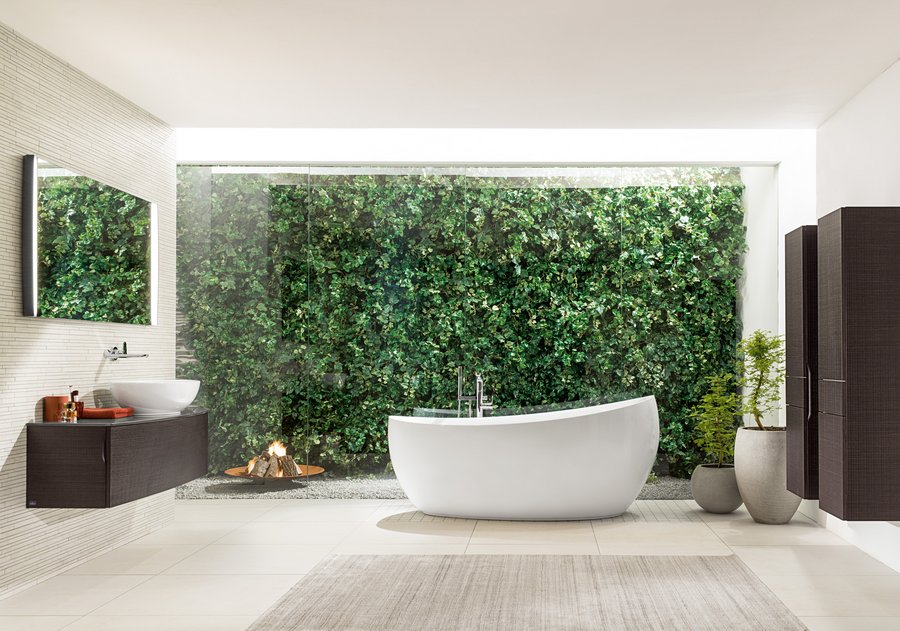Nature Bathroom

Photo: Villeroy & Boch
Background: hansgrohe
A
bathroom dream in green
When it
comes to ecology, the bathroom has had an excellent track record for quite some
time. Thanks to the optimisation of tap spouts and the jets on hand and
overhead showers, the amount of water consumed by fittings has been reduced to
a minimum. As for materials, premium sanitary ceramic permits mono-material
recycling, while top-quality design extends the useful life of any bathroom
sanitaryware. The growing trend towards natural materials for the bathroom
walls and ceiling confirms the Ecological Bathroom’s credentials once and for
all.
The path to
a sustainable bathroom isn’t only paved with highly complex technical products
and state-of-the-art technologies; products made of natural materials that can
be used for many years also play a vital role. The Nature Bathroom is a future
concept that strives for the optimal combination of water- and energy-saving
products, eco-friendly industrial production, sustainable materials and
enduring design – while simultaneously conveying a sense of being in touch with
nature.
Today’s
green bathroom has come a long way from the tree-hugging image of the first
generation. On the contrary: it is characterised by high-tech products like
sensor-controlled fittings that only dispense water when it’s needed,
water-saving toilet flushing systems and hand showers that provide an
impeccable showering experience even at low flow rates thanks to air-filled
water droplets – which, needless to say, are always at the optimal temperature
the individual user has selected via the programmable thermostatic controls.
Energy losses incurred as a result of adjusting the settings are thus largely
avoided. Besides helping to save energy and water, LED bathroom lighting and
various technical features increase comfort and convenience as well – and are
easy on both the wallet and the conscience.
The trend towards the Nature Bathroom is being driven from two sides: on
the one hand by rational necessity, and on the other by a general desire for a
close-to-nature experience. But even if
the industry and its designers are coming up with plenty of ideas, it’s
ultimately the consumer who decides how much convenience they want and how much
energy and water they are willing to use to get it. It starts with pressing the
economy flush option on the cistern and ends with a question of conscience:
should I bath or shower? Luckily, there are now cleverly designed bathtubs with
ergonomically shaped interiors that need a smaller volume of water to fill them
to the top. Nevertheless, showering is still far more economical. There’s no
getting round it: a bath is a very special luxury – and not only in terms of
environmental aspects.
Products for the bathroom with added ecological value
When it
comes to the water requirement of modern toilet systems, the savings potential
has already been pushed to the limit. Modern toilets can easily manage with
three to six litres of water per flush without leading to hygiene problems or
unpleasant odours. Rimless toilets also make for easy cleaning and thus help
save on detergents.
But there’s
more to the Nature Bathroom than saving water. Water stands for vitality and
sensuousness as well. The popularity of beautifully designed fittings that
stage the water in a particularly sensual and natural way indicates just how
important contact with this life-giving element is to people. Waterfall mixers
– which are now available in economical versions too – and fittings that
dispense non-pressurised water make us forget the complex technology they
contain and remind us that water is an immensely valuable resource. The Nature
Bathroom stages water as a life-giving element and makes it tangible as a
precious commodity.
Naturalness and sustainability with traditional materials
The
question of which materials to use is another, totally different aspect of
planning a sustainable bathroom. For as nice as a soft mossy carpet and wooden
floorboards might be, tiles, stone or concrete are far more practical and less
sensitive to water. Natural materials like lime plaster, granite or marble cut
a fine figure, and even clay paint and clay plaster are ideal for use in the
bathroom. As a rule, plastic shower curtains are neither hygienic nor
recyclable – a glass enclosure is a far more sustainable option. And by the
way: when it comes to saving plastic, little things can make a big difference
too, like using a ceramic dispenser for liquid hand wash – or swapping it for a
good old-fashioned bar of soap instead.
Nowadays,
quite a few manufacturers offer suitable bathroom furniture in cosy designs and
an abundance of variants. Even solid wood furniture is feasible in the
bathroom, as demonstrated by the collections from Keuco or burgbad.
When it
comes to choosing the materials for their sanitaryware, fans of the Nature
Bathroom have it pretty easy: after all, what other material is as
non-hazardous to produce, as safe for the indoor climate and of such enduring
quality as ceramic? And if it’s coated with a dirt-repellent finish, it even
saves on cleaning products as well. At most, only the steel-enamel tub or
shower tray – likewise available with a dirt-repellent glaze – can rival
ceramic in terms of robustness and durability. And with some manufacturers
offering guarantees of up to 30 years, even the energy-intensive production of
steel-enamel appears in a more acceptable light – demonstrating just how
important timeless design and top-quality products are in the bathroom. Because
ultimately, the most sustainable bathroom of all is one that will last a long
time and continue to look just as attractive as the day it was fitted.
